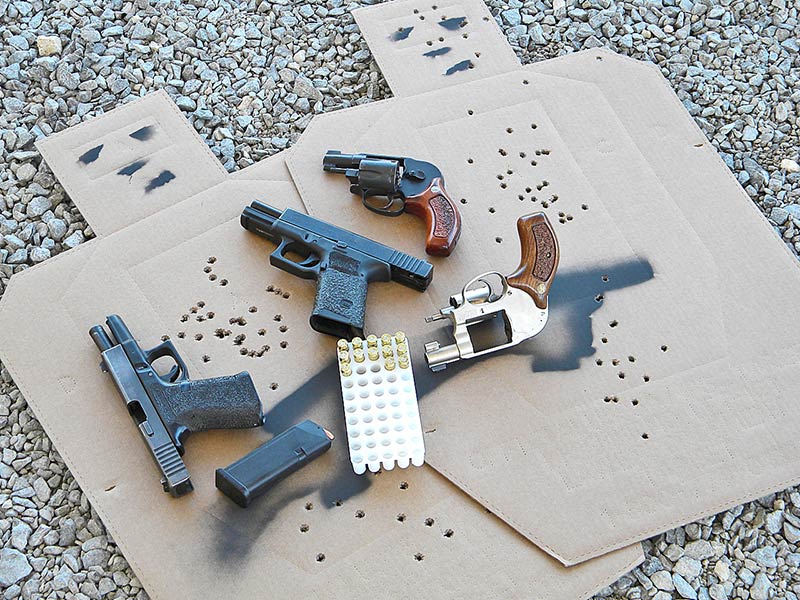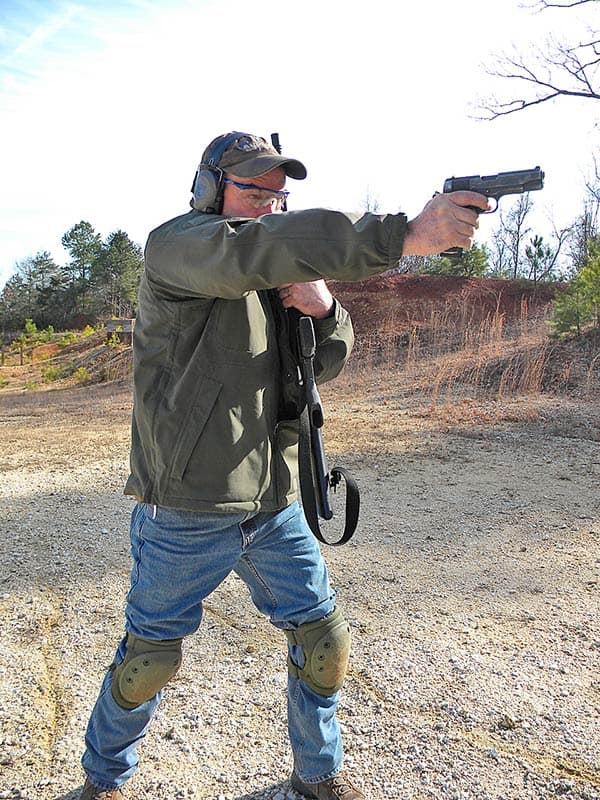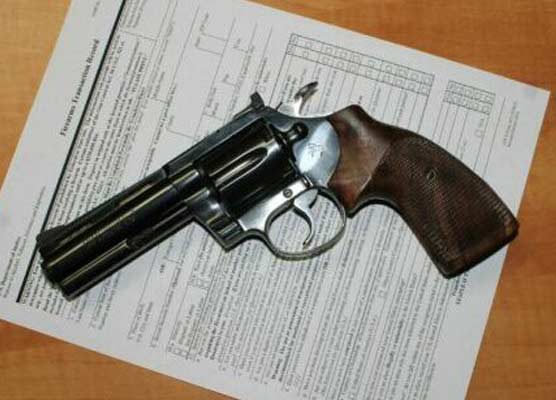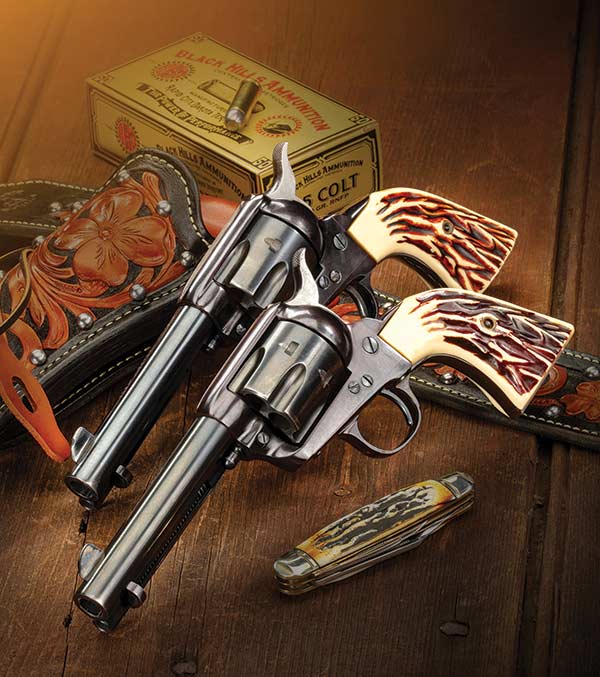Why Not Pack A Pair?
Applying This Classic Carry Mode in The Real World
I’ve always carried two flashlights, knives and two pistols — one on my side and the second in a pocket or ankle holster. For the past few months, I’ve been wearing two pistols on the belt, one on each side. I figured this would be a fun experiment and maybe learn something in the process. Along the way, I made some interesting discoveries, and my two-gun test turned out to actually have some applications for everyday carry.
The Two-Fer Twist
The experiment began by researching the works of others. Ed McGivern’s Fast And Fancy Revolver Shooting has a chapter on two-gun work. He recommends starting out slow, firing one pistol at a time, never sacrificing accuracy for speed. For defensive purposes, J. Henry FitzGerald’s Shooting advises working up close, firing “… double action and pointing, no sights used, the arms stiffened when the muzzle is pointed in the right direction.”
McGivern suggests using two guns of the same type, size and weight. I have several pairs of matching pistols, but since I was following advice from McGivern and FitzGerald, I started “old school” with a pair of pre-Model 10 S&W K-Frames in .38 Special, both with 4-inch barrels. I already had right- and left-hand leather holsters by Bill McLennan — a Thunder Ranch instructor who operates Texas Gun Leather — plus an assortment of speedloaders, strips and pouches.
My training routine begins with a lot of dry-practice. Revolvers are great for this. In double-action the trigger rotates the cylinder, cocks and drops the hammer. Release or reset the trigger and you’re good to go again. Another advantage — which is more difficult to explain — is this: I still like revolvers “more better” than semi-autos. There’s just something about them that works, and I’ve always shot them more accurately than semi-autos. Readers who grew up on revolvers know what I’m talking about.
Dry Practice
I load up with dummy ammo and dry practice 10 or 15 minutes a day. “Filling” each hand, I draw both pistols at once. As soon as the sights hit the target I smoothly stroke the triggers one at a time. After a little of this I practice pressing both triggers at once. Working with both hands at the same time feels a lot more natural than I anticipated. I research this phenomenon and discover the concept of “bilateral coordination,” our natural ability to use both sides of the body at the same time for controlled movements. Your hands and arms can perform the same tasks, like drawing two guns at once or opposite-type actions such as pushing with one arm while pulling with the other.
During dry-practice, I quickly discover that the physical part of two-gun work isn’t that difficult. The mental aspect requires three or four times more thought. According to Hick’s Law, the more options you have to choose from the longer it takes to make a decision. After “firing” both pistols, I holster the left one, reload the right, holster it and draw the left one to reload. To get a good feel for it, I vary the sequence, reloading the left and then right side. I “fire” two rounds from each, then holster one and perform a “tactical” reload with the other, removing the two “fired” cases and replacing them with two rounds from a speed strip.
It takes time to determine what sequence of holstering, drawing and loading works best. Especially considering you can hold the pistol in the hand you’re firing to load it or transition it to the other hand. Plenty of practice is necessary with the different variations of holstering and reloading to determine which sequence is most efficient.
Practical Applications
During dry-practice I’m already thinking about the practical applications of carrying two pistols for defense. Obviously there’s Jim Cirillo’s “New York Reload,” drawing another pistol instead of reloading the first one. This same thing applies to malfunctions or a stoppage. For a breakage or jam, which takes time and tools to correct, there’s a definite advantage to carrying pistols. With two pistols you can arm a partner; you’d just have to be real sure about who you’d give the weapon to.
The visual aspects of working with two guns are very interesting. Firing one pistol and then the other is just a matter of shifting your visual focus from one set of sights to the other. Since this experiment is supposed to be fun, my main interest is in seeing what could be done firing both pistols at once. I don’t have a dominant eye, so I can actually get a sight picture with both sets of sights.
After extensive dry-practice, I head to the range to see how “theory” applies when the actual shootin’ starts. For range work, I switch to a pair of S&W J-Frames, working at three yards. These snubbies are matching work pistols. The internals have been slicked up, the face of the triggers polished and radiused. The triggerguards are narrowed slightly and both sport XS Tritium Dot front sights. Since they’ve both seen hard use, it won’t matter if they get dinged up in the process.
I already have right- and left-hand holsters from Alan Miller at Aholster. They are slim, an advantage for concealed carry, and you can take them off and put them on without having to undo your belt. Alan’s revolver holsters have a concave cut on the top, which works well for easier holstering.
Starting out slow, I draw both pistols onto the “A” zone and fire them at the same time. This is when I discover how important trigger weight is. On the range, one pistol always fires before the other, regardless of which hand is using it. I check them using my Lyman electronic gauge I got from Brownells. One trigger is two pounds heavier than the other. Using Wolff springs, again from “Big B,” I tune them until both triggers are within two ounces of each other at 9 pounds, 6 ounces.
With matching trigger weights, I’m pretty pleased with my live fire. At close distance with a large target I can get a “flash” sight picture — a quick visual confirmation of the front sight on target — and I score good hits. I was putting two hits on target at a speed the timer recorded as one shot. The press and recoil is simultaneous or at least close enough it seems to be the same. I also discover firing both pistols at the same target causes them to bang into each other during recoil. Good thing I switched over to my work guns. Scratches and dings on them just add character.
Putting simultaneous shots into the chest area with both pistols is pretty easy and fun. After a few drills of this, I start using one pistol to put hits into the chest and hit the pelvic area with the other, again firing both at the same time. Putting hits in two locations on the same target works better than I anticipated. Then for fun I try making one head shot while firing two or three into the chest. Again, better than I anticipated, and with practice it will only improve. Could you do it under realistic conditions, when your body is flooded with a chemical cocktail against a live? I’m not sure, but I do know it’s some fun shooting.
After using the revolvers a little I switch to a pair of GLOCK 19’s. At first I get a couple of stovepipes. I get more aggressive with my stance and push my arms forward at the shoulders. This cures that problem. I also get a big surprise. When using two guns, I’m more accurate with the semi-autos than the revolvers. My group size tightens up considerably and the shots are a little quicker due to the lighter recoil. Initially I didn’t think shooting the GLOCKs would be much different than using the revolvers, but now I know better.

If you carry a second gun, make sure you practice gun-handling skills with it. Here, a lineup at Tiger’s school spends
time getting familiar with the new muscle memories of drawing from an ankle holster. If you carry a second gun, make sure you practice gun-handling
skills with it. Here, a lineup at Tiger’s school spends time getting familiar with the new muscle memories of drawing from an ankle holster.
The Carry Question
It’s not long before I get used to carrying two pistols. Now it doesn’t feel right unless I have one on each side. Carrying two guns around home, which is where my office and range are, isn’t a big deal. Everyone who comes here, including the delivery guys, knows what I do. They don’t even bat an eye when they see me walking around with an AR on my shoulder. But concealing two guns for carry in public is going to take some figuring.
Carrying exact duplicates is, no doubt, the best option. But for me it also presents some problems. I normally carry a full size pistol on my strong side. With my body size carrying 1911’s or my GLOCK 19’s on each side isn’t an option. It’s going to show or print unless it’s winter and I’m wearing heavy clothing. I was talking about this with my friend Harry, who partially inspired this experiment. The one thing about being a big man, he explains, is the ability to carry two full-size pistols inside your waistband, covered by a sport coat. No one ever notices.
I can carry two smaller pistols such as a pair of S&W J-Frames or Ruger LCR’s. Small autos like the GLOCK 42 or 43 also work well. These are slim enough that they don’t bulge out my hips. A golf or sport shirt conceals them well. Having the same type pistols makes swapping between them easy.
Real-World Examples
Is there a legitimate need to carry more than one pistol? History says “yes.” On December 19, 1854, Jon athan R. Davis, a military veteran, killed 11 armed outlaws at Rocky Canyon near Sacramento, California using two Colt revolvers and his Bowie knife. This is one of the deadliest fights in American history involving one man against multiple foes. There was a reason men carried weapons in those days.
What about more contemporary examples? I contact Mas Ayoob. Probably the most famous example he mentions is Lance Thomas, a watch dealer in L.A.. Thomas has defeated multiple armed robbers, using more than one pistol in all but his first gunfight. He had pistols positioned all around his shop within easy reach. In another robbery, a young clerk at a stop-and-rob, Ayoob tells me, “pulled his primary gun on a robber, who jumped him and got it away from him.” The kid pulled a backup gun, stopping the threat just in time
After wearing the smaller pistols for a while, I start carrying a full-size one on the right side and a smaller gun on the left. I put an S&W K-Frame on the right side, a J-Frame on my left side and another “J” on my ankle. The .38 Special ammo carried in a pouch or strip fits all three weapons. So now I’m carrying three pistols. I see the worried looks on my wife’s face. “Don’t worry,” I assure her, “it’s just for an article.” Gretchen doesn’t say anything, but I’m not sure she’s buying it.
Lasers, Accessories
During my drills I start thinking about lasers. I’ve never been much of a point shooter, but pistols equipped with lasers might be just the ticket. Lasers would allow you to point and aim two guns at once without needing to see the sights. You could fire from unusual positions when it might not be possible to obtain a sight picture. Revolvers will work well for this since you don’t have to worry about providing resistance for them to function. Without the proper grip or resistance, semi-autos will experience failures to eject.
My experiment also brought up some good ideas for regular carry as well. For example, everyone carries their spare magazines on the support side of the body. This works well. The primary hand holds the pistol, and the other hand handles the mags, until you’re injured in the support hand. The biggest problem we see with students running injury drills is watching them reaching around their body with the strong hand to acquire a mag on the opposite side of their body for a reload. Carrying a spare mag in front of the holster on your strong side solves this problem. We’re not talking about a lot of weight or belt space, and it sure makes that strong-side empty-reload a lot more efficient.
Final Thoughts
Is working and shooting two guns at once fun? Yes. It was a great departure from the standard range drills. And if you try it you’ll probably be surprised with the results. Just remember, safety is always your main focus. Dry practice first with dummy weapons. After getting a feel for that and ensuring fingers aren’t getting on the triggers at the wrong time, then work dry with your real pistols. Once that’s feeling good, go to the range. Start your live fire out slow, firing one at a time with each hand. Then start firing both at the same time. Fight the urge to go fast. Usually after getting an idea of what we’re doing, we start wanting to speed up. This is a bad thing. Slow down. This ensures safety and, by going slower, you have time to think about each aspect of working with two guns.
Personal protection is an individual responsibility. It’s up to you to protect yourself and family. It only makes sense to approach this with serious intent. If there’s a need to carry one, it makes sense to have two.
For more info:
Aholster www.lefthandholster.com
Texas Gun Leather ww.txgunleather.wix.com/gunleather)
Tiger McKee is director of Shootrite Firearms Academy (www.shootrite.org). He is also the author of “The Book of Two Guns” (www.shootrite.org/book/book.html).














